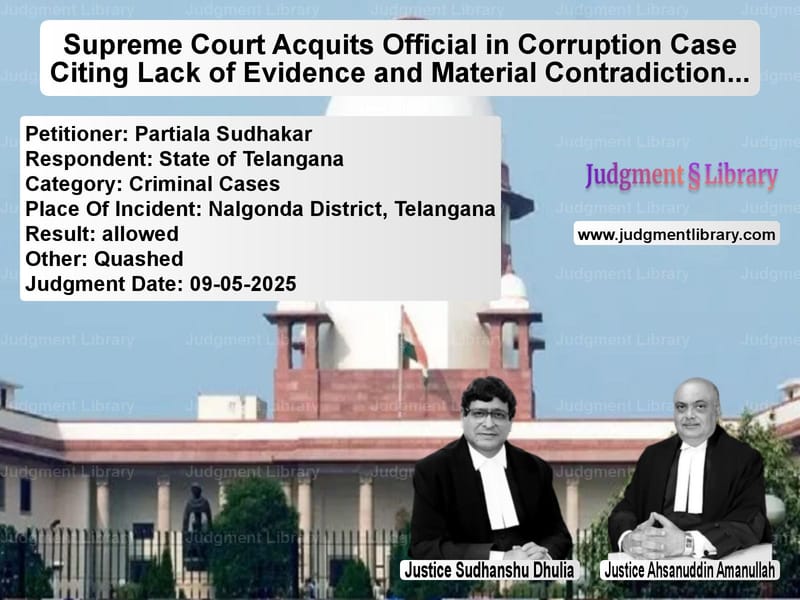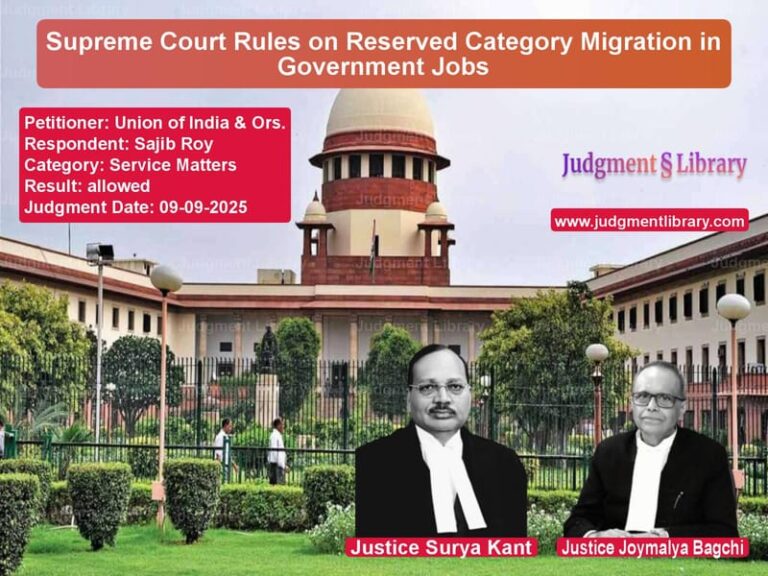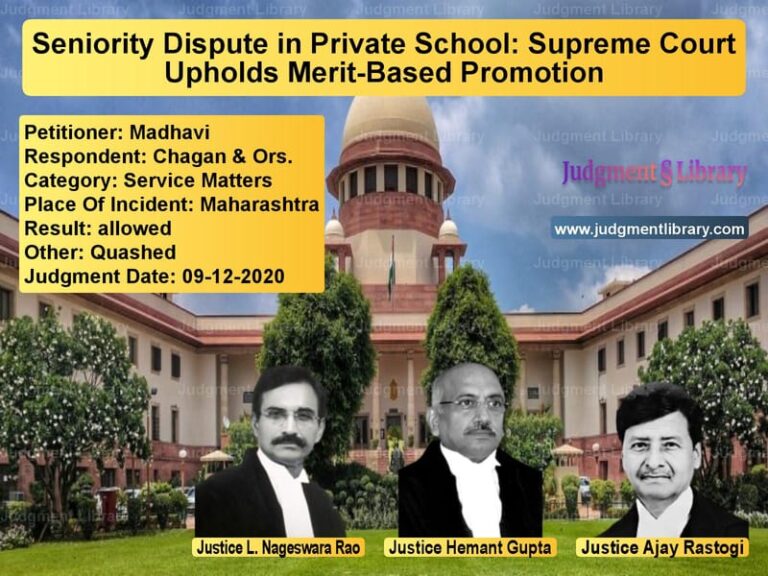Supreme Court Acquits Official in Corruption Case Citing Lack of Evidence and Material Contradictions
In a significant judgment that underscores the fundamental principle of ‘proof beyond reasonable doubt’ in criminal jurisprudence, the Supreme Court has acquitted a 70-year-old former Revenue Inspector who had been convicted in a corruption case dating back to 2003. The case involved allegations of bribe demand and acceptance, but after nearly two decades of legal battle, the apex court found that the prosecution had failed to establish its case with the required certainty. The judgment serves as a crucial reminder that in criminal cases, especially those involving serious charges like corruption, the evidence must be clear, consistent, and convincing enough to leave no reasonable doubt about the accused’s guilt.
The appellant, Partiala Sudhakar, was working as a Revenue Inspector in the Mandal Revenue Office at Gundala Mandal, Nalgonda District, between 2001 and 2003. The case against him began when a complainant approached him regarding compensation for trees that had dried up due to drought. According to the prosecution, on August 6, 2003, the appellant demanded a bribe of Rs. 2,000 to conduct an inquiry and prepare a report. When the complainant expressed inability to pay such an amount, the appellant allegedly reduced the demand and asked him to bring the money to his residence on August 11, 2003. This led to the registration of a case under the Prevention of Corruption Act, and a trap was laid by the Anti-Corruption Bureau.
The Prosecution’s Case and Trial Court Conviction
According to the prosecution’s version, on the day of the trap, the complainant met the appellant at the Mandal Revenue Office, after which the appellant asked him to meet at Ambala Village. Later, both went to the complainant’s house, where the appellant visited the garden to inspect the damaged trees. After returning to the house and having tea, the appellant allegedly instructed the complainant to keep the bribe amount in a rexine bag attached to the petrol tank of his motorcycle. The complainant did so and then signaled the trap party. However, when the trap party approached and conducted tests on the appellant’s hands, they proved negative. The money was nevertheless recovered from the rexine bag.
Based on this evidence, the Trial Court convicted the appellant in 2008, sentencing him to one year of rigorous imprisonment and a fine for offences under Section 7 and Section 13(1)(d) read with Section 13(2) of the Prevention of Corruption Act. The High Court later upheld this conviction in March 2024, leading to the appeal before the Supreme Court.
The Appellant’s Arguments
The appellant’s senior counsel raised several crucial arguments challenging the prosecution’s case. He contended that “the triple test for gauging trustworthiness of trap cases i.e., (i) Prior verification of demand by investigator; (ii) use of shadow witness, and; (iii) successful pH test are entirely absent, in the instant case.” This highlighted fundamental flaws in how the trap was conducted and evidence gathered.
Counsel further argued that “the entire factual matrix surrounding the alleged bribe is extremely flawed. It was submitted that the alleged demand was made during the late evening of 11.08.2003 at PW1’s house where there were no independent witnesses. The demand was also not heard by any of the trap team members who were present at the scene of the incident.” This absence of independent corroboration was a significant weakness in the prosecution’s case.
Perhaps most importantly, the appellant’s counsel revealed that “the complainant also failed to disclose the fact that he had previously approached the MRO for grievance(s) regarding drought compensation, and this had led to a prior altercation with the Appellant. This shows a further insight into the entire (alleged) crime being a farce and a ploy to take revenge from the Appellant, due to prior animus between the Appellant and PW1.” This suggested a possible motive for false implication.
The counsel also pointed to contradictory evidence, noting that “While referring to DW1’s (complainant’s wife) statements, it was pointed out that her narration of the events that transpired completely contradicted the one given by the complainant-PW1. In fact, the wife had not supported the case of any demand being made at the time when both parties were present in the house.”
The State’s Defense
The respondent-State argued for upholding the conviction, contending that “ordinarily, a demand for illegal gratification would not be made openly by corrupt officials to avoid being reported and to safeguard their reputation. Therefore, the absence of other direct witnesses to the demand would not amount to controverting or denying the demand but would only suggest that the same was not made in the presence of other persons.”
The State’s counsel also challenged the motive argument, submitting that “there is no motive for complainant to falsely concoct a story against the Appellant and even if the altercation between complainant and the Appellant is believed to have taken place, it was an attempt by the Appellant to signal to the complainant that his application for compensation would be rejected unless he approves it. This was nothing more than a prelude to the demand being made by the Appellant of illegal gratification and it only strengthens the Respondent’s case.”
Regarding the recovery of money, the State argued that “as noted by the Trial Court, there is a clear line of sight from inside the house towards where the Appellant’s motorcycle was parked. Therefore, even in such scenario, it is clear that the currency notes were placed in the Appellant’s bag with his knowledge and upon his instructions, hence, establishing the acceptance of illegal gratification.” The State also relied on the presumption under Section 20 of the Prevention of Corruption Act.
The Supreme Court’s Analysis
The Supreme Court began its analysis by acknowledging the fundamental principles of criminal jurisprudence. The Court referred to its earlier judgment in Yogesh Singh v Mahabeer Singh, noting that “It is well settled in law that the minor discrepancies are not to be given undue emphasis and the evidence is to be considered from the point of view of trustworthiness. The test is whether the same inspires confidence in the mind of the court. If the evidence is incredible and cannot be accepted by the test of prudence, then it may create a dent in the prosecution version. If an omission or discrepancy goes to the root of the matter and ushers in incongruities, the defence can take advantage of such inconsistencies.”
The Court further emphasized in Krishnegowda v State of Karnataka that “the guilt of the accused has to be proved beyond reasonable doubt and this is a classic case where at each and every stage of the trial, there were lapses on the part of the investigating agency and the evidence of the witnesses is not trustworthy which can never be a basis for conviction. The basic principle of criminal jurisprudence is that the accused is presumed to be innocent until his guilt is proved beyond reasonable doubt.”
Applying these principles to the present case, the Court found “material contradictions in the evidence of the witnesses.” The Court noted that “PW3 had stated that a few days prior to the incident, there was hot talk between the complainant-PW1 and the Appellant, and in fact, PW3 had reprimanded the Appellant for quarrelling with PW1. However, the High Court has disbelieved this aspect without assigning any reason(s) for the same.”
The Court identified crucial inconsistencies in the complainant’s testimony, observing that “PW1’s version itself during his deposition before the Trial Court is self-contradictory, inasmuch as initially he stated in his examination-in-chief that both he and the accused officer came back to his house and were drinking tea inside the house, when PW1 came out and kept the amount in the rexine bag attached to the petrol tank of the Appellant’s bike. However, when he was re-examined by the Public Prosecutor concerned, PW1 stated that the Appellant was with him when the tainted currency was kept in the rexine bag attached to the petrol tank.”
This contradiction was particularly significant because “if the Appellant had come out of the house along with PW1 and in full view of the trap party members who were just 20 yards away and could witness the signal from PW1 of removing his spectacles and wiping it and then they would, but naturally, also have seen that PW1 had directly kept the bribe amount in the rexine bag attached to the petrol tank of the motorcycle of the Appellant.”
The Court found the sequence of events described by the prosecution highly questionable, noting that “the actual circumstances leading to the recovered notes being kept by the complainant-PW1 directly in the rexine bag attached to the petrol tank of the motorcycle of the Appellant are not forthcoming.” The testimony of DW1, the complainant’s wife, further complicated matters as she stated that “her husband/PW1 went outside the house and again came back inside the house with the Appellant. Thereafter, DW1 states, after consuming tea, both went outside. Subsequently, the trap party entered the house along with PW1 and the Appellant.”
The Court concluded that “from all the official versions of the witness’ depositions before the Trial Court, the claimed/projected sequence of events by the prosecution-Respondent, of both (i) the money being placed in the rexine bag attached to the petrol tank of the Appellant’s bike, and; (ii) its recovery as also whether the same was in the presence of the Appellant, does not seem to inspire confidence. The same cannot be said to have been proved beyond reasonable doubt, in our considered opinion.”
Referring to Suresh Thipmppa Shetty v State of Maharashtra, the Court reiterated that “when the Court is to choose between the version proffered by the prosecution vis-à-vis the defence version, in the face of reasonable doubt towards the prosecution story, the Court should lean in the defence’s favour.”
Benefit of Doubt and Presumption Under the Act
The Court addressed the State’s argument regarding the presumption under Section 20 of the Prevention of Corruption Act, holding that “our analysis supra would indicate that the factum of demand, in the backdrop of an element of animus between the Appellant and complainant, is not proved. In such circumstances, the presumption under Section 20 of the Act would not militate against the Appellant.”
The Court relied on Om Parkash v State of Haryana, which held that “where demand has not been proved, Section 20 will also have no application.” This was crucial in determining that the foundational requirement for invoking the presumption – proof of demand – was absent in this case.
Conclusion and Acquittal
After thorough examination of the evidence and legal principles, the Supreme Court concluded that “on an overall circumspection of the facts and circumstances of the case, the evidence on record and for reasons stated above, we find that the guilt of the Appellant has not been proved beyond reasonable doubt. Having found so, this is a case where benefit of doubt was required to be given to the Appellant.”
Accordingly, the Court allowed the appeal, set aside the conviction and sentence, and quashed the judgments of the courts below. The appellant, who had been fighting the legal battle for nearly two decades and was now 70 years old, was finally acquitted and granted the benefit of doubt.
This judgment reinforces several fundamental principles of criminal law: the presumption of innocence, the requirement of proof beyond reasonable doubt, the importance of consistent and reliable evidence, and the necessity of proper investigation procedures in corruption cases. It serves as a reminder that while combating corruption is essential, it must be done within the framework of due process and fair trial guarantees that form the bedrock of our criminal justice system.
Petitioner Name: Partiala Sudhakar.Respondent Name: State of Telangana.Judgment By: Justice Sudhanshu Dhulia, Justice Ahsanuddin Amanullah.Place Of Incident: Nalgonda District, Telangana.Judgment Date: 09-05-2025.Result: allowed.
Don’t miss out on the full details! Download the complete judgment in PDF format below and gain valuable insights instantly!
Download Judgment: partiala-sudhakar-vs-state-of-telangana-supreme-court-of-india-judgment-dated-09-05-2025.pdf
Directly Download Judgment: Directly download this Judgment
See all petitions in Fraud and Forgery
See all petitions in Bail and Anticipatory Bail
See all petitions in Custodial Deaths and Police Misconduct
See all petitions in Extortion and Blackmail
See all petitions in Other Cases
See all petitions in Judgment by Sudhanshu Dhulia
See all petitions in Judgment by Ahsanuddin Amanullah
See all petitions in allowed
See all petitions in Quashed
See all petitions in supreme court of India judgments May 2025
See all petitions in 2025 judgments
See all posts in Criminal Cases Category
See all allowed petitions in Criminal Cases Category
See all Dismissed petitions in Criminal Cases Category
See all partially allowed petitions in Criminal Cases Category







